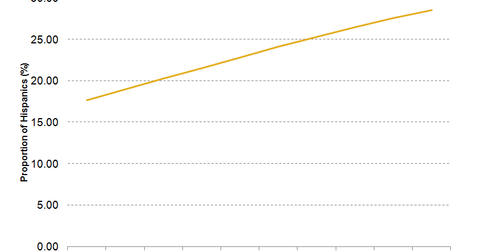Macy’s target consumers: Do they make a difference?
Macy’s target consumers include Millennials. The company launched collections aimed at Millennials, including QMack, Maison Jules, and Bar III Carnaby.
Feb. 6 2015, Updated 9:05 a.m. ET

Macy’s core demographic
Macy’s target consumers for the Macy’s brand stores are the American middle class who prefer quality products at reasonable prices. The company’s stores under the Bloomingdale’s brand offer high-end customers an assortment of established brands such as Armani, Burberry, Chanel, ChristianDior, David Yurman, Gucci, Jimmy Choo, John Varvatos, Louis Vuitton, and Prada.
The Hispanic fashion brand
Retailers are focusing on the country’s fast-growing Hispanic population. According to the U.S. Census Bureau, Hispanics account for about 17% of the US population. In 2013, Macy’s entered into an exclusive deal to market a new fashion brand called Thalia Sodi. The brand is promoted by Thalia, a popular music star of Mexican origin. The retailer plans to introduce this line of apparel, shoes, and jewelry at 300 stores in spring 2015.
Are Millennials important?
Department stores and other players in the retail industry are focusing on Millennials, people between the ages of 16 and 34. According to Boston Consulting Group (or BCG), Millennials account for $1.3 trillion in annual spending. At least $430 billion of that is estimated to be spent on discretionary products.
Millennials are well informed and closely follow their brands and products through digital networks. Macy’s target consumers include Millennials. The company has launched several collections specifically aimed at Millennials, including QMack, Maison Jules, and Bar III Carnaby.
Focus on local tastes
One of Macy’s (M) core strategies is My Macy’s, which focuses on localizing product assortment based on store location. Macy’s ensures that local tastes and preferences are reflected in the merchandise size, fit, style, and color of a particular store. Macy’s also keeps in mind the tastes of multicultural buyers, who represent a major portion of its customers.
Competition’s target customers
Nordstrom, Inc. (JWN) caters to high-end customers, while Sears Holdings Corp. (SHLD) focuses on consumers with lower disposable income. TJX Companies, Inc. (TJX) follows an attractive strategy of selling off-price value products to both high-end and middle-class customers.
As of January 30, 2015, the Consumer Discretionary Select Sector SPDR Fund (XLY) had 6.26% holdings in multiline retailers like Macy’s.
